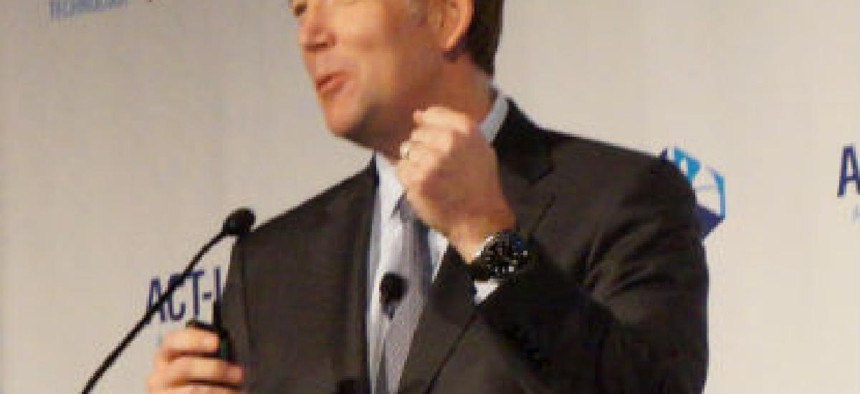VanRoekel: Tech and innovation are 'prevailing theme' in 2015 budget

At ACT-IAC's "Igniting Innovation" event, federal CIO stresses opportunities, cultural obstacles for agency change-makers.

Federal CIO Steven VanRoekel, speaking at the ACT-IAC "Igniting Innovation" event.
Federal CIO Steven VanRoekel, speaking at a Feb. 6 ACT-IAC event, offered a tease to the federal IT community about the fiscal 2015 budget.
While he would not offer specifics -- "we haven't presented it to Congress yet," he noted -- VanRoekel declared that "the prevailing theme throughout ... is tech and innovation. It drives everything we do."
The remarks came at "Igniting Innovation," a half-day event sponsored by ACT-IAC's Institute for Innovation with the goal of highlighting innovative IT already in government use. The event showcased 30 projects, and VanRoekel praised the teams behind them for showing that it's possible to innovate within the constraints of agency cultures and limited budgets.
"We have a modest tech budget compared to the federal budget, but we are moving a sector of the economy through our actions," he said.
The project chosen as the overall Igniting Innovation winner, though not mentioned by VanRoekel, was a case in point. The Environmental Protection Agency's My Waterway app, which provides plain-language assessments of the water conditions for virtually every U.S. waterway, was based entirely on existing EPA data, architecture and services. AT&T Federal President Kay Kapoor, who helped judge the projects, called it "awesome citizen service, plain and simple."
The bulk of VanRoekel's keynote focused on what he described as the key components of innovation: culture, people and the ability to break the entropy.
The anecdotes were familiar to those who have heard VanRoekel speak before -- focusing on the customer, the need to fail fast, the importance of stylish socks -- but his advice boiled down this:
1. Establish a buddy system. VanRoekel encouraged the IT leaders in attendance to spend more time building relationships with their peers in acquisition, personnel and elsewhere. Real change can't happen in a tech vacuum, he said. With the 30 projects showcased at the event, "I bet if you trace it back, it was a lawyer in the [general counsel]'s office who wrote a decision that allowed them to do that. Or I bet it was someone in acquisition." So for the next event, he suggested, "bring along someone from acquisition."
2. Bring in the private sector. "Think about the use of challenges" to get input from outside government, VanRoekel suggested. He praised the Presidential Innovation Fellows' ability to inject new ideas, but also urged agencies to "use your ability to do Schedule A hiring ... and take advantage of those ways to bring in the private sector."
VanRoekel stressed, however, that the outside input must complement, not work around, the career staff. Recalling how a Federal Communications Commission staffer referred to "red laws and the blue laws" -- i.e., the actual written regulations versus the old habits that had become baked into the culture -- he stressed that "we need to think about how we get the employees of government to embrace innovation as a culture," so that it doesn't dissipate when appointees leave.
3. Think small. VanRoekel decried the government assumption that "to do more, you must spend more."
"Big idea leads to big specification leads to big RFP leads to big vendor leads to big solution," he said. "That is not sustainable." He challenged the audience instead to "think about what you can do for under $10,000," or "under the simplified acquisition threshold of $150,000."
"This is not just an IT opportunity," VanRoekel said. "It's an everything opportunity."





